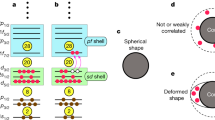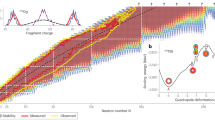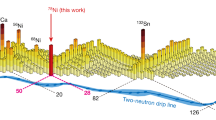Abstract
Superheavy nuclei represent the limit of nuclear mass and charge; they inhabit the remote corner of the nuclear landscape, whose extent is unknown. The discovery of new elements with atomic numbers Z ≥ 110 has brought much excitement to the atomic and nuclear physics communities. The existence of such heavy nuclei hangs on a subtle balance between the attractive nuclear force and the disruptive Coulomb repulsion between protons that favours fission. Here we model the interplay between these forces using self-consistent energy density functional theory; our approach accounts for spontaneous breaking of spherical symmetry through the nuclear Jahn–Teller effect. We predict that the long-lived superheavy elements can exist in a variety of shapes, including spherical, axial and triaxial configurations. In some cases, we anticipate the existence of metastable states and shape isomers that can affect decay properties and hence nuclear half-lives.
This is a preview of subscription content, access via your institution
Access options
Subscribe to this journal
Receive 51 print issues and online access
$199.00 per year
only $3.90 per issue
Buy this article
- Purchase on Springer Link
- Instant access to full article PDF
Prices may be subject to local taxes which are calculated during checkout





Similar content being viewed by others
References
Heenen, P.-H. & Nazarewicz, W. Quest for superheavy nuclei. Europhys. News 33, 1–9 (2002)
Strutinsky, V. M. Shells in deformed nuclei. Nucl. Phys. A 122, 1–33 (1967)
Sobiczewski, A., Gareev, F. A. & Kalinkin, B. N. Closed shells for Z > 82 and N > 126 in a diffuse potential well. Phys. Lett. 22, 500–502 (1966)
Myers, W. D. & Swiatecki, W. J. Nuclear masses and deformations. Nucl. Phys. 81, 1–60 (1966)
Nilsson, S. G. et al. On the nuclear structure and stability of heavy and superheavy elements. Nucl. Phys. A 131, 1–66 (1969)
Ćwiok, S., Dobaczewski, J., Heenen, P.-H., Magierski, P. & Nazarewicz, W. Shell structure of the superheavy elements. Nucl. Phys. A 611, 211–246 (1996)
Schwerdtfeger, P. & Seth, M. B. in Encyclopedia of Computational Chemistry Vol. 4, 2480–2494 (Wiley, New York, 1998)
Bender, M., Rutz, K., Reinhard, P.-G., Maruhn, J. A. & Greiner, W. Shell structure of superheavy nuclei in self-consistent mean-field models. Phys. Rev. C 60, 034304 (1999)
Kruppa, A. T. et al. Shell corrections of superheavy nuclei in self-consistent calculations. Phys. Rev. C 61, 034313 (2000)
Bender, M., Nazarewicz, W. & Reinhard, P.-G. Shell stabilization of super-and hyperheavy nuclei without magic gaps. Phys. Lett. B 515, 42–48 (2001)
Ćwiok, S., Pashkevich, V. V., Dudek, J. & Nazarewicz, W. Fission barriers of transfermium elements. Nucl. Phys. A 410, 254–270 (1983)
Möller, P. & Nix, J. R. Stability of heavy and superheavy elements. J. Phys. G 20, 1681–1747 (1994)
Armbruster, P. On the production of superheavy elements. Acta Phys. Polon. B 34, 1825–1866 (2003)
Julin, R. In-beam spectroscopy of heavy actinides. Nucl. Phys. A 685, 221–232 (2001)
Ren, Z. Shape coexistence in even-even superheavy nuclei. Phys. Rev. C 65, 051304 (2002)
Bürvenich, T., Bender, M., Maruhn, J. A. & Reinhard, P.-G. Systematics of fission barriers in superheavy elements. Phys. Rev. C 69, 014307 (2004)
Hoffman, D. C., Ghiorso, A. & Seaborg, G. T. The Transuranium People (World Scientific, River Edge, New Jersey, 2000)
Hofmann, S. & Münzenberg, G. The discovery of the heaviest elements. Rev. Mod. Phys. 72, 733–767 (2000)
Hofmann, S. et al. Properties of heavy nuclei measured at the GSI SHIP. Nucl. Phys. A 734, 93–100 (2004)
Ginter, T. N. et al. Confirmation of production of element 110 by the 208Pb(64Ni,n) reaction. Phys. Rev. C 67, 064609 (2003); erratum C68, 029901 (2003)
Morita, K. et al. Status of heavy element research using GARIS at RIKEN. Nucl. Phys. A 734, 101–108 (2004)
Morita, K. et al. Experiment on the synthesis of element 113 in the reaction 209Bi(70Zn,n)278113. J. Phys. Soc. Jpn. 73, 2593–2596 (2004)
Oganessian, Yu. Ts. et al. Heavy element research at Dubna. Nucl. Phys. 734, 109–123 (2004)
Moody, K. & the Dubna–Livermore Collaboration . Superheavy element isotopes, decay properties. Nucl. Phys. A 734, 188–191 (2004)
Oganessian, Yu. Ts. et al. Measurements of cross sections for the fusion-evaporation reactions 244Pu(48Ca,xn)292-x114 and 245Cm(48Ca,xn)293-x116. Phys. Rev. C 69, 054607 (2004)
Kohn, W. & Sham, L. J. Self-consistent equations including exchange and correlation effects. Phys. Rev. A 140, 1133–1138 (1965)
Bender, M., Heenen, P.-H. & Reinhard, P.-G. Self-consistent mean-field models for nuclear structure. Rev. Mod. Phys. 75, 121–180 (2003)
Perlínska, E., Rohozínski, S. G., Dobaczewski, J. & Nazarewicz, W. Local density approximation for proton-neutron pairing correlations: formalism. Phys. Rev. C 69, 014316 (2004)
Stoitsov, M. V., Dobaczewski, J., Nazarewicz, W., Pittel, S. & Dean, D. J. Systematic study of deformed nuclei at the drip lines and beyond. Phys. Rev. C 68, 054312 (2003)
Chabanat, E., Bonche, P., Haensel, P., Meyer, J. & Schaeffer, R. A Skyrme parametrization from subnuclear to neutron star densities. Part II: nuclei far from stabilities. Nucl. Phys. A 635, 231–256 (1998)
Bonche, P., Flocard, H., Heenen, P.-H., Krieger, S. J. & Weiss, M. S. Self-consistent calculation of triaxial deformations: application to the isotopes of Kr, Sr, Zr, and Mo. Nucl. Phys. A 443, 39–63 (1985)
Nazarewicz, W. Microscopic origin of nuclear deformations. Nucl. Phys. A 574, 27c–49c (1994)
Pashkevich, V. V. The energy of non-axial deformation in heavy nuclei. Nucl. Phys. A 133, 400–404 (1969)
Larsson, S. E., Ragnarsson, I. & Nilsson, S. G. Fission barriers and the inclusion of axial asymmetry. Phys. Lett. B 38, 269–273 (1972)
Götz, U., Pauli, H. C. & Junker, K. Influence of asymmetric distortions on fission barriers. Phys. Lett. B 39, 436–438 (1972)
Wood, J. L., Heyde, K., Nazarewicz, W., Huyse, M. & Van Duppen, P. Coexistence in even-mass nuclei. Phys. Rep. C 215, 101–201 (1992)
Acknowledgements
We thank M. Bender, J. Dobaczewski and M. Stoyer for discussions. This work was supported in part by the US Department of Energy, by the National Nuclear Security Administration under the Stewardship Science Academic Alliances programme, by the Belgian Science Policy Office, by NATO, and by the Polish Committee for Scientific Research (KBN).
Author information
Authors and Affiliations
Corresponding author
Ethics declarations
Competing interests
The authors declare that they have no competing financial interests.
Rights and permissions
About this article
Cite this article
Ćwiok, S., Heenen, PH. & Nazarewicz, W. Shape coexistence and triaxiality in the superheavy nuclei. Nature 433, 705–709 (2005). https://doi.org/10.1038/nature03336
Received:
Accepted:
Issue Date:
DOI: https://doi.org/10.1038/nature03336
This article is cited by
-
The periodic table of the elements: the search for transactinides and beyond
Rendiconti Lincei. Scienze Fisiche e Naturali (2022)
-
Systematics on production of superheavy nuclei \(Z = 119-122\) in fusion-evaporation reactions
Nuclear Science and Techniques (2021)
-
The periodic table and the physics that drives it
Nature Reviews Chemistry (2020)
-
Nuclear Level Density and the Structural Dynamics of Rotating Superheavy Nucleus Z = 117
Brazilian Journal of Physics (2020)
-
Superheavy nuclei and hypernuclei: extending the limits of the nuclear chart
Journal of Radioanalytical and Nuclear Chemistry (2019)
Comments
By submitting a comment you agree to abide by our Terms and Community Guidelines. If you find something abusive or that does not comply with our terms or guidelines please flag it as inappropriate.



